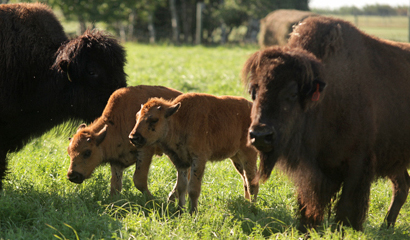
Wood bison embryo transfer a success
University of Saskatchewan veterinary scientists and colleagues across Canada have recently carried out the world’s first successful embryo transfer in wood bison.
This story was initially published in the Saskatoon Star Phoenix in 2011.
In mid-June, two wood bison calves were born at the university’s Native Hoofstock Centre, 16 kilometres southeast of Saskatoon.
Success was achieved after four years of work with researchers from University of Calgary, the Northwest Territories, and the Calgary and Toronto zoos.
“Aside from being a first for Canadian researchers, it really shows that we can produce disease-free, healthy wood bison using this model,” says U of S researcher Dr. Gregg Adams, who led the project.
“Also, anything we learn about wood bison is very likely translatable to plains bison, which is important in raising plains bison for parks or agricultural products.”
Dr. Manuel Palomino, a graduate student from Peru pursuing his PhD in reproductive science and medicine at the Western College of Veterinary Medicine (WCVM), was part of the team.
“This has been a great opportunity for me,” he says. “I’ve learned new skills that I wouldn’t have been able to develop in my country due to the lack of facilities, equipment and even researchers.”
Found mainly in Alberta’s Wood Buffalo National Park and in the Northwest Territories, the wood bison population has been drastically reduced due to two infectious bacterial diseases that can affect mammals and humans—brucellosis and tuberculosis (TB).
“Wood bison are considered a threatened Canadian species,” Palomino said. “It’s very important to maintain this emblematic animal within Canada.”.
In 1985, Canada was declared free of brucellosis and TB in domestic livestock, but these diseases continue to infect the wood bison population.
To avoid transmission to domestic cattle and otherwise uninfected wood bison, federal environment officials recommended that the diseased population in Wood Buffalo National Park be eradicated.
The goal of the embryo transfer research is to replace existing herds with healthy wood bison with similar genetic make-up.
In 2006, a small herd of bison was donated to the U of S by Alberta’s Elk Island National Park. A WCVM research team began detailed ultrasound examinations of the females to better understand the normal reproductive pattern of this wild species.
Palomino’s primary role in the project was to synchronize the ovarian follicle growth among the female bison so they’d be ready for embryo collection at about the same time.
“I’ve had previous experience using follicular ablation—an accurate technique for re-synchronizing the development of ovarian follicles,” he says.
The procedure essentially resets the ovaries to zero. Then the team gives hormonal treatments to the female bison, stimulating multiple follicle development and superovulation.
Artificial insemination is then performed, and seven days later, researchers harvest the fertilized eggs (embryos) from the donor female’s uterus for transfer into a healthy recipient.
Last fall, the team attempted embryo transfer for the first time using fresh embryos—and the bison calves were the successful result.
“The techniques are here—we now know that it’s possible to produce viable embryos in wood bison,” says Palomino.
The next challenge is to attempt embryo transfer using frozen embryos. Researchers ultimately hope to store a whole herd of embryos in liquid nitrogen for future re-population of wood bison.
Investigators also plan to use their innovative approach—synchronization of ovarian follicle development followed by hormonal treatments—to lengthen the wood bison’s breeding season.
“We’d like to get the bison cycling throughout the year so we can collect embryos year-round,” says Palomino.
Funders include the Advancing Canadian Agriculture and Agri-Food Program, the World Wildlife Fund, Canada-Saskatchewan Agri-Food Innovation Fund, the N.W.T. government, and the Canadian Bison Association.
Robyn Thrasher is a second-year veterinary student at the WCVM. She was a student intern with the WCVM Research Communications office and U of S Research Communications during the summer of 2011.
